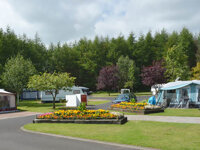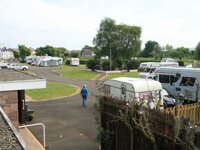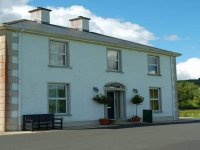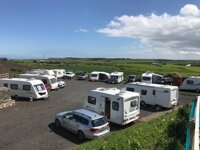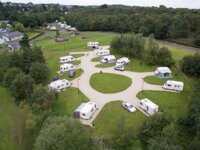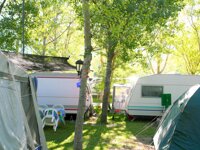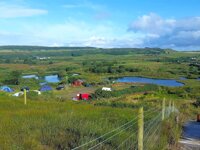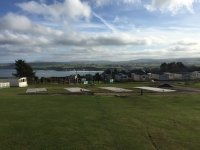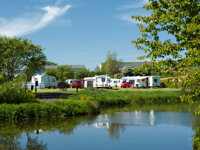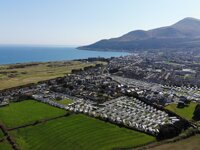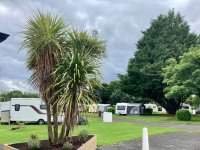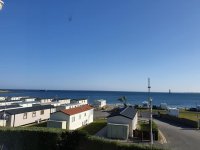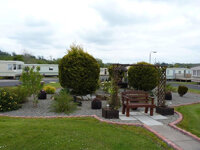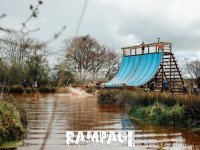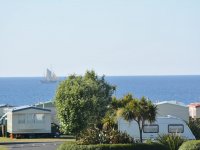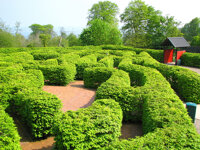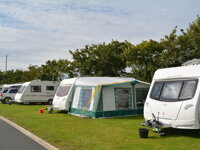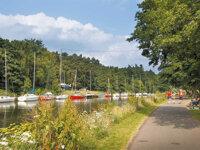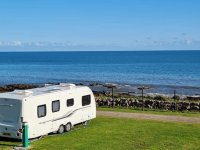Northern Ireland
22 campsites in Northern Ireland
Campsite Listing Google Map
The following consent is required:
Tracking & performance, Targeting & advertising.
Northern Ireland
From the vibrancy of Belfast to the stark beauty of the Giant’s Causeway, camping in Northern Ireland opens up a world of ancient legend and diverse scenery. Fermanagh’s predominant features are its lakes and waterways, which provide a haven for boating, fishing and watersports. Conversely, the Sperrin mountains rise and fall over the northeast of County Tyrone and are a picturesque walking spot.
With a diversity of unspoilt landscapes, ranging from wild coastlines to green valleys, rugged mountains and shimmering lakes, to the natural phenomenon of the Giant’s Causeway, Northern Ireland, though small, is crammed full of sights offering something for everyone.
The rugged coastline of the Causeway Coast and the nine Glens of Antrim in the north, is an Area of Outstanding Natural Beauty, with white sandy shores and little bays, tranquil forests and romantic ruins and castles, full of tales of the ancient Irish Giants and other myths and legends. At over 60 million years old, with a mass of 4,000 tightly packed basalt columns, each a polygon shape, the Giant’s Causeway is a great attraction.
One of the most beautiful regions is in the west around Londonderry, a delightful walled city set on a hill on the banks of the Foyle estuary. Further south is the beautiful region of Fermanagh, with glistening lakes and little islands all surrounded by lush green fields, hillsides and forests. The large lake of Lough Erne is to be found here: made up of two channels, the lower and upper Loughs, the meeting point of these channels is Enniskillen, a town steeped in history, boasting numerous preserved buildings including a castle.
Across to the eastern shores lies the ancient Kingdom of Down, with its endless miles of spectacular coastline, little fishing villages, country parks and the Mountains of Mourne. And, ringed by hills, sea lough and river valley is Belfast, a bustling city full of theatres, concert halls, art galleries and restaurants.
Northern Ireland comprises the following counties: Antrim, Armagh, Down, Fermanagh, Londonderry and Tyrone
Unknown matrix block type: tableOfContents2!
Basic Information

Capital Belfast
Currency Pound Sterling (GBP)
Language(s) English/Gaelic
Time Zones GMT (UTC+0)
Summer IST (UTC+01)
Telephone Code +44
Units Metric
EU Member No
Schengen Area No
Tourism Website discovernorthernireland.com
Northern Ireland is not a member of the European Union, and customs inspections are conducted on individuals and vehicles crossing the border to ensure compliance with Northern Ireland's regulations. Read more about the border with Ireland on the UK Government Website.
Places of interest
Antrim: Antrim Lough Shore Park; Rathlin Island; Giant’s Causeway; Dunluce Castle near Portrush; Carrick-a-Rede Rope Bridge.
Belfast & environs: Belfast zoo and castle; Irish Linen Centre in Lisburn; Carrickfergus Castle; Crown Liquor Saloon.
Armagh: Gosford Forest Park near Markethill; Lough Neagh Discovery Centre on Oxford Island; Ardress House.
Down: County Museum and Downpatrick Cathedral; Mourne Mountains; Tollymore and Castlewellan forest parks; Ballycopeland Windmill near Millisle.
Fermanagh: Enniskillen Castle and Castle Coole; village of Belleek; Marble Arch Caves, near Lough Macnean; Devenish Island on Lough Erne.
Londonderry: St Columb’s Cathedral; Tower Museum; Mural Tours; Foyle Valley Railway Centre in Derry.
Tyrone: Omagh; Beaghmore stone circles near Cookstown; Dungannon; Sperrin Mountains.
Did you know?

- Northern Ireland measures 85 miles from north to south and is about 110 miles wide.
- The world’s most famous ship, the Titanic, was built in Belfast.
- Legend has it that the rugged Giant’s Causeway was built by Finn McCool, the legendary Irish Giant, when he travelled to Scotland to bring back his sweetheart.
- At 2,240 yards, an Irish mile is 480 yards longer than a standard English mile.
- Mountsandel near Coleraine is where Ireland’s first known house was built 9,000 years ago.
Shopping in Northern Ireland
Shopping in Northern Ireland is similar to in other parts of the UK, with a mix of local markets, high street stores and shopping centres. Cities like Belfast, Derry/Londonderry, and Newry have a range of high-street stores offering clothing, electronics, home goods, and more. Popular shopping areas include Donegall Place and Victoria Square in Belfast and The Quays Shopping Centre in Newry.
Many towns and cities in Northern Ireland host local markets, especially on weekends. St. George's Market in Belfast is one of the most famous markets in Northern Ireland, offering a diverse range of food, crafts, antiques, and more. Don't miss the chance to try traditional Northern Irish foods like soda bread, potato bread, and local cheeses. These can often be found in local markets or grocery stores. Northern Ireland is also known for its excellent whiskey production. Look for speciality liquor stores or distilleries offering a wide range of Irish whiskeys. St. George's Market can get busy, it's only open on Friday, Saturday and Sunday, so consider arriving early to avoid crowds. It's a fantastic place to experience the local culture, interact with friendly vendors, and sample traditional Northern Irish food. Remember that the market may have special events or themes on certain days, so check their official website.

Northern Ireland has a rich tradition of craftsmanship and artwork. Look out for local crafts shops and galleries that offer unique handmade products and paintings. If you're looking for souvenirs, consider traditional Irish crafts, textiles, pottery, and locally produced foods. Look for items adorned with Celtic knots, symbols, and designs, such as keychains, magnets, and ornaments.
Most shops, including retail stores and shopping centres, typically open around 9:00 a.m. from Monday to Saturday. Shops generally close around 5:00 p.m. although some larger stores might have extended hours, staying open until around 8:00 p.m. on certain days. There are laws regulating Sunday trading hours. Larger shops and retail centres are usually permitted to open from 1:00 p.m. until 6:00 p.m. on Sundays.
Money in Northern Ireland
Credit and debit cards are widely accepted in shops, restaurants, and other businesses. Visa and MasterCard are commonly used, and contactless payments are also prevalent. However, carrying some cash with you is advisable; ATMs are easily found throughout Northern Ireland.
Public Holidays in Northern Ireland
- New Year's Day: 1st January
- Saint Patrick's Day: 17th March
- Good Friday, Easter Monday*
- May Day: 1st Monday in May
- Spring Bank Holiday: Last Monday in May
- Battle of the Boyne / Orangemen's Day: 12th July
- Summer Bank Holiday: Last Monday in August.
- Christmas Day: 25th December
- Boxing Day: 26th December
Please note Some dates are moveable, so please check before travelling.
Driving in Northern Ireland
Visitors to Northern Ireland who wish to drive in the country must comply with the following requirements:
- A valid driver's license: Visitors must have a valid driver's license from their home country.
- Car insurance: Visitors must have valid car insurance for their vehicle, covering both the driver and passengers.
- Road rules: In Ireland, motorists drive on the left and overtake on the right. Drivers must not attempt any overtaking if it could cause inconvenience to others.
- The use of seat belts is mandatory for all occupants of a vehicle. Visitors must follow Irelands traffic laws, including speed limits, traffic signals, and road signs. Cars entering a roundabout should give priority to those already on it unless otherwise indicated. Signs at uncontrolled junctions will highlight the presence of a main road.
- Horns must not be used between the hours of 23:30 and 07:00 on any road that has a permanent speed limit enforced.
- Safety equipment: A red warning triangle is compulsory in case of an accident or breakdown. It is recommended that visitors equip their vehicle with a fire extinguisher and a first-aid kit, a reflective jacket, and Spare bulbs for your car's external lights
- Camper vans and cars with caravans are not allowed to exceed 18.75 metres in length, 4.65 metres in height and 2.55 metres in width.
- Minimum driving age: The minimum driving age is 17 years old.
- Alcohol law: When caught drink driving, If the level of alcohol in the bloodstream exceeds 0.02 per cent, severe penalties include licence suspension.
Emergency Services in Northern Ireland
Northern Ireland's emergency number for life-threatening emergencies.
To accessFire, police, ambulance and coastguard 999
Weather in Northern Ireland
BELFAST WEATHERNorthern Ireland has a temperate maritime climate, which means it experiences mild temperatures and relatively consistent weather patterns throughout the year. However, the weather can be quite changeable, and it's always a good idea to be prepared for rain, no matter the season. Here's an overview of the typical weather you can expect throughout the year:
Spring (March-May):
- Spring in Northern Ireland is characterised by mild temperatures, with highs ranging from 10°C to 14°C. It's a relatively dry season compared to winter, but showers are still common, so an umbrella is recommended.
Summer (June - August):
- Summers are mild and generally pleasant, with average highs around 16°C to 18°C. Rainfall increases compared to spring, but you can also experience extended periods of sunshine. Daylight hours are long, providing ample time for outdoor activities.
Autumn (September - November):
- Autumn brings cooler temperatures, with highs ranging from 12°C to 14°C in September and dropping to 8°C to 10°C in November. Rainfall continues to increase, and the weather becomes more unpredictable.
Winter (December - February):
- The Winters in Northern Ireland are generally mild, with average highs around 6°C to 8°C. Frost and snow are possible but not as common as in other parts of the UK. Rainfall remains consistent, and the region can be damp during this season.
